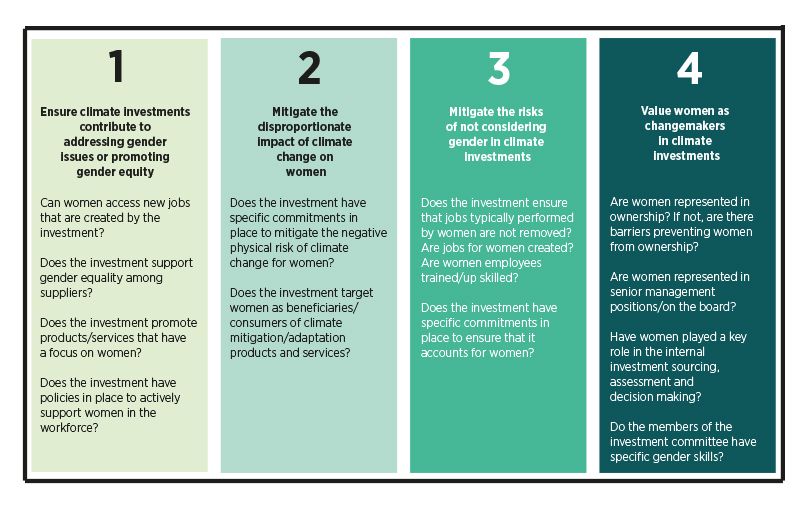The Women in Finance Climate Action Group (WFCAG) has created a framework to integrate a gender lens into climate investing to ensure women are seen as key stakeholders in solutions, and a more impactful and shorter just transition.
Research by WFCAG found women are disproportionately impacted by the negative effects of climate change, yet they have the capacity to act as “critical changemakers in addressing the climate emergency”, according to its report Applying a gender lens to climate investing: An action framework.
It said: “Women make up 80% of people displaced by climate change and are 14 times more likely to die or be injured in a natural disaster than men. While they are often the victims of climate change, they are also critical stakeholders in designing and implementing solutions. Studies have found that increased representation of women in parliament correlates with reduced C02 emissions through more stringent climate change policies.”
Created in collaboration with 2X Global, Aviva, and the Oliver Wyman Forum, and supported by the 30% Club, the framework comprises three areas of guidance.
First, it encourages companies to define target outcomes that address gender-related issues and mitigate the disproportionate impact of climate change on women, while valuing women as climate changemakers, and second, it says firms need to align organisation and investment processes with these target outcomes. The latter can include setting gender-lens targets when setting portfolio climate targets and monitor progress against these, and also engaging with climate portfolio companies on gender stewardship progress.
Finally, the framework seeks to guide firms on how to integrate various metrics, such as the number of women employees or working in supply chains, access for women to products/services, financial inclusion and supporting women entrepreneurs. The framework urges companies to collect this data and disclose it to investors to articulate how a gender lens is being applied to climate strategies.
Overview of example guidance for investment analyst teams & investment committees

The report added: “This framework was developed with a thorough review of existing gender-specific and climate-specific frameworks and data sources, particularly 2X criteria, to provide a simple and practical tool for investors. It considers women in all capacities as framed by 2X –as business owners, leaders, employees, consumers, and beneficiaries of financial intermediaries – to compile a list of key metrics for investors to integrate into their organisation and investment processes.”
It also said the framework has been developed with input from asset managers, venture capital and private equity firms, and development finance institutions as well as gender lens and sustainable finance. It is designed to be additive and work in conjunction with existing climate frameworks such as the Taskforce for Climate-related Financial Disclosures and the Glasgow Financial Alliance for Net Zero.
Amanda Blanc, Aviva’s group CEO, said: “The global private finance sector does not currently have the tools or incentives in place to evaluate and improve the impact of climate finance on gender equality.
“We need more data to measure the impact of specific climate investments or project financing on women and girls. We hope this framework will give financial institutions what they need to begin to measure and deliver greater gender equality when taking action on net zero.”
Rupal Kantaria, partner at Oliver Wyman Forum and head of climate for the 30% Club, added: “This first-of-its-kind action framework for investors embeds gender considerations into climate investment decisions. Both are critical for financing a faster and more just climate transition.”








